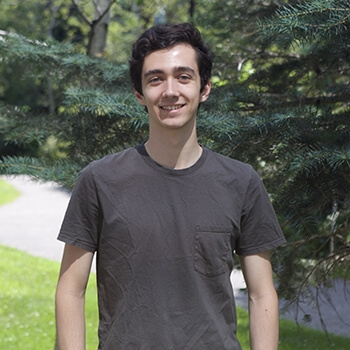Improving human function through exosuit development
Joseph Sanchez, S.B. ’21, a mechanical engineering concentrator at the Harvard A. Paulson School of Engineering and Applied Sciences, has a passion for science. Though he initially planned to become a veterinarian or doctor, his interest in engineering was sparked by a middle school rocketry program in his small hometown in Texas.
Sanchez has been able to further pursue his interest in mechanical engineering at Harvard, already garnering success this past winter during MakeHarvard, a 24 hour makeathon where students produce engineering prototypes.
“My team built a smart physical therapy brace for the elbow and we ended up taking second place,” he explained. “Post-competition, we decided to take the prototype to a couple of professors in related fields on campus and see whether they would recommend further pursuing the idea.”
Sanchez and his friend approached Conor Walsh, Gordan McKay Professor of Engineering and Applied Sciences, since they had taken one of his classes. Walsh offered them the opportunity to contribute to an alternative project.
Working in Harvard’s BioDesign Lab, Sanchez has had the opportunity to work with Walsh and his colleagues as they create exosuits. These exosuits are soft, wearable robots made from uniquely engineered fabric to assist and protect the human body. Their innovative design seeks to minimize interference with natural body functions while allowing synergistic interaction with the wearer, according to the lab. In essence, these suits should help minimize tension and stress on joints and muscles to improve the body’s performance. Practical applications include aiding soldiers and assembly line workers, as well as assisting those with physical or neurological disorders.
“I am working specifically on the inflatable shoulder project, building a one-to-one model of the human shoulder that we can use to better qualify and understand how our exosuits perform due to the difficulties of collecting data on people,” explained Sanchez. “It’s a mechanical linkage system that will move in the same way a human shoulder does.”
Having little anatomy background, Sanchez is learning first-hand the complexity of the human shoulder and its mechanics.
“It is a very complicated joint and I did not appreciate that,” he said. “We are about a week behind where I thought I would be by now, but it’s definitely a learning process for sure. You solve one issue and two more show up.”
Despite facing setbacks, Sanchez is hoping to continue his work this year. Having this research experience under his belt has allowed him to be open to new opportunities in the future, even looking outside the field of mechanical engineering at the business side of engineering.
